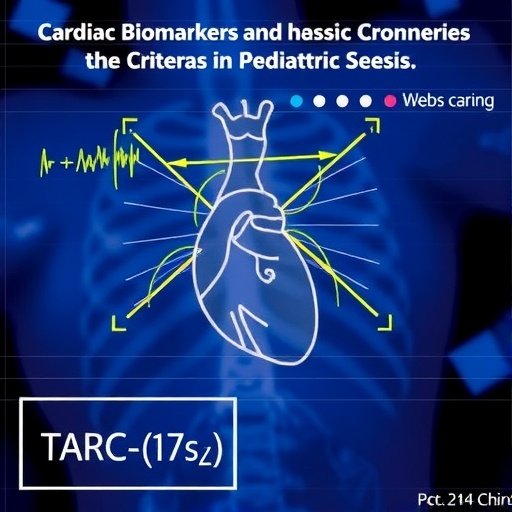A groundbreaking study published in BMC Pediatrics has shed new light on the significance of cardiac biomarkers in assessing pediatric sepsis. This retrospective cohort study, conducted by İpek, Güllü, and Güngör, highlights the prognostic capabilities of specific cardiac markers when combined with the Phoenix criteria, presenting a novel approach for early detection and better management of sepsis in children.
Sepsis remains one of the leading causes of morbidity and mortality in pediatric populations worldwide. The complex nature of this condition often hinders timely diagnosis and intervention. Traditional methods for evaluating sepsis can be limited, prompting researchers to explore alternative indicators that might offer more insight into a patient’s condition. Among these, cardiac biomarkers have emerged as valuable diagnostic tools due to their association with cardiovascular dysfunction, a common issue in septic patients.
The study emphasizes the importance of swift diagnosis in the context of pediatric sepsis. Early identification can drastically improve outcomes, as timely initiation of appropriate treatment can help reverse the life-threatening effects of sepsis. As evidence mounts regarding the implications of cardiac health during infections, the integration of cardiac biomarkers into routine assessment protocols could revolutionize clinical practice.
Cardiac biomarkers, such as troponin, natriuretic peptides, and C-reactive protein, are increasingly recognized for their roles in managing various acute conditions, including sepsis. The current study meticulously documents how these biomarkers assist clinicians in predicting adverse outcomes. By measuring levels of these proteins in patients with suspected sepsis, healthcare providers gain a clearer picture of the underlying pathophysiological changes, which can inform treatment strategies.
The Phoenix criteria, developed as a comprehensive framework for assessing clinical deterioration, prove critical in this investigation. When combined with cardiac biomarkers, the Phoenix criteria enhance the predictive capacity for severe outcomes in pediatric patients. This synergistic approach allows for a more holistic view of a child’s health status, enabling an informed decision-making process that could directly impact survival rates.
Understanding the implications of incorporating cardiac markers into sepsis evaluation is a crucial component of this research. The findings indicate a heightened specificity and sensitivity when these biomarkers are utilized alongside traditional diagnostic criteria. This dual approach could facilitate quicker recognition of septic shock and the initiation of urgent interventions that are vital for improving survival.
Furthermore, the retrospective nature of the study emphasizes the need for robust longitudinal research to further validate the findings. A large dataset was analyzed, allowing for a comprehensive overview of the associations between cardiac markers and patient outcomes. These relationships underscore the necessity of collecting high-quality data that can direct future clinical trials aimed at optimizing sepsis management.
In the face of rising pediatric sepsis cases, the research by İpek and colleagues is particularly timely. As healthcare systems strive to improve treatment protocols and reduce preventable deaths, innovative approaches like those outlined in this study will be instrumental in shaping future guidelines. By prioritizing cardiac health in the context of infection, pediatricians can better anticipate complications and tailor therapies to individual needs.
The potential for widespread implementation of these findings is significant. As the medical community continues to understand the intricate links between cardiac function and infection, training programs for healthcare providers can be updated to include these pivotal insights. Expanded awareness and recognition of the role of cardiac biomarkers can empower clinicians and enhance patient outcomes on a global scale.
Of course, further research is needed to explore the mechanisms by which these biomarkers reflect underlying pathophysiological processes in children with sepsis. Understanding these mechanisms will guide additional advancements in pediatric critical care. Future investigations could also explore different populations and varied illness severities to ensure comprehensive applicability of the findings.
Ultimately, this study paves the way for an evolution in how pediatric sepsis is approached in clinical settings. By merging traditional diagnostic modalities with innovative biomarkers, healthcare providers can be better equipped to face the challenges posed by this complex condition. As research continues to evolve, the hope is that pediatric sepsis will become more manageable, with fewer lives lost due to this often-overlooked illness.
In conclusion, the work of İpek and colleagues stands as a beacon of progress in the fight against pediatric sepsis. By enhancing our understanding of the role of cardiac biomarkers and the Phoenix criteria, the study provides a solid foundation upon which future clinical practices can be built. This intersection of research and clinical application underscores the ongoing commitment within the medical community to improve patient care and outcomes.
Subject of Research: Prognostic value of cardiac biomarkers in pediatric sepsis
Article Title: Prognostic value of cardiac biomarkers and Phoenix criteria in pediatric sepsis: a retrospective cohort study
Article References:
İpek, S., Güllü, U.U., Güngör, Ş. et al. Prognostic value of cardiac biomarkers and Phoenix criteria in pediatric sepsis: a retrospective cohort study.
BMC Pediatr (2025). https://doi.org/10.1186/s12887-025-06374-1
Image Credits: AI Generated
DOI: 10.1186/s12887-025-06374-1
Keywords: pediatric sepsis, cardiac biomarkers, Phoenix criteria, prognosis, retrospective cohort study, early detection, morbidity, mortality, diagnosis, treatment.




